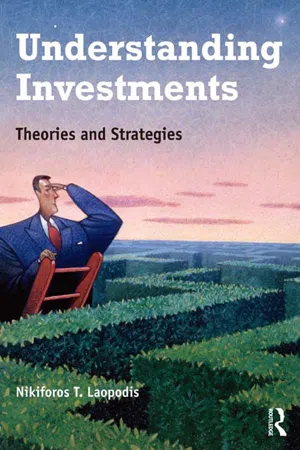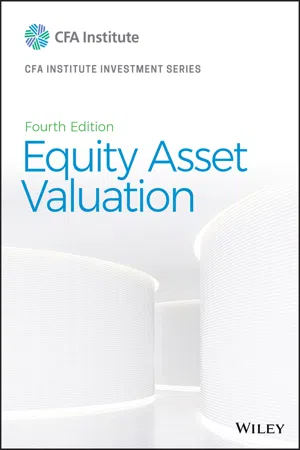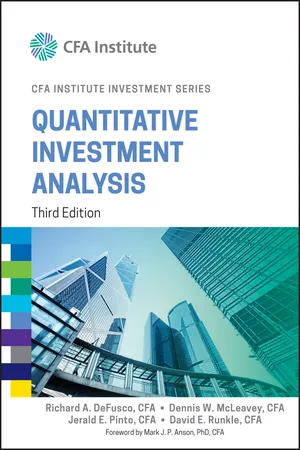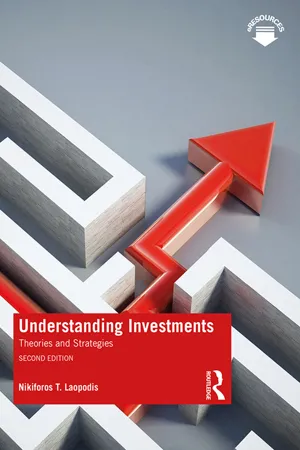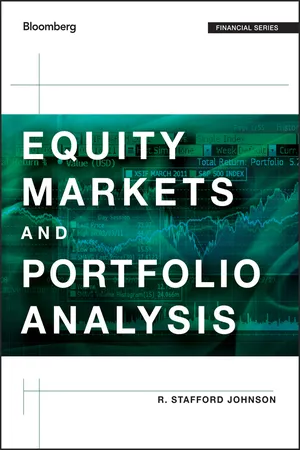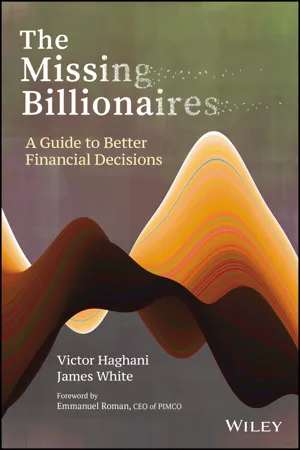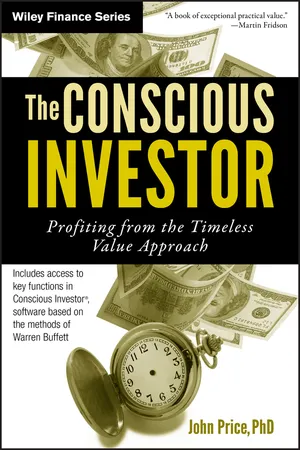Economics
Expected Return
Expected return refers to the anticipated profit or loss from an investment, calculated by multiplying the potential outcomes by their respective probabilities and summing the results. It provides a measure of the average gain or loss an investor can expect over time. Expected return is a key concept in investment decision-making and risk assessment.
Written by Perlego with AI-assistance
Related key terms
8 Key excerpts on "Expected Return"
- eBook - ePub
Understanding Investments
Theories and Strategies
- Nikiforos T. Laopodis(Author)
- 2012(Publication Date)
- Routledge(Publisher)
In this chapter, we discussed in detail the two basic elements of investing: risk and Expected Return. The objective of the investor is to maximize his Expected Return subject to constraints including risk. Therefore return is a crucial metric for the investor’s success, and we showed how to calculate and interpret it. There are several ways in which we can measure return: realized or holding period return, Expected Return, real return, and required return. We also demonstrated two other ways to measure the return of an asset such as the arithmetic mean, the geometric mean, and the effective annual rate. In view of all above measures of return, the investor is mostly concerned with the Expected Return, which is based on future estimates of return.The second component in an investment decision is risk. In this chapter we also showed how to measure and interpret the risk of the individual securities the investorBOX 3.2The St. Petersburg ParadoxThe original person who coined this paradox was Daniel Bernoulli in 1738, when he presented the problem and its solution in his book Commentaries of the Imperial Academy of Science of St. Petersburg . The paradox is as follows.In a game of chance, you pay a fixed fee to play and then a fair coin is repeatedly flipped until a tail appears. If a tail appears, the game ends. By contrast, if a head appears, you gain $1, and the gain is doubled ($2, $4, ..) every time a head appears. Thus you win $1 if a tail appears on the first toss, $2 if a head appears on the first toss, and a tail on the second toss, and so on. What would be the fair price to pay to play this game? Using probabilities, the expected value of all coin flips (with their gains) would sum up to infinity! For example, you win $1 with a probability of 1/2, $2 with a probability of 1/4, $4 with a probability of 1/8, etc. The sum of all these probabilities would be equal to infinity, suggesting that the price to pay would be an infinite sum. Alternatively stated, no finite entrance fee would make this game fair. - eBook - ePub
- Frank J. Fabozzi, Frank J. Fabozzi(Authors)
- 2012(Publication Date)
- Wiley(Publisher)
i is calculated as follows. First, a probability distribution for the possible rates of return that can be realized must be specified. A probability distribution is a function that assigns a probability of occurrence to all possible outcomes for a random variable. Given the probability distribution, the expected value of a random variable is simply the weighted average of the possible outcomes, where the weight is the probability associated with the possible outcome.In our case, the random variable is the uncertain return of asset i . Having specified a probability distribution for the possible rates of return, the expected value of the rate of return for asset i is the weighted average of the possible outcomes. Finally, rather than use the term “expected value of the return of an asset,” we simply use the term “Expected Return.” Mathematically, the Expected Return of asset i is expressed as(4)whereRn= the n th possible rate of return for asset ipn= the probability of attaining the rate of returnRnfor asset i N = the number of possible outcomes for the rate of returnHow do we specify the probability distribution of returns for an asset? We shall see later on in this entry that in most cases the probability distribution of returns is based on long-run historical returns. If there is no reason to believe that future long-run returns should differ significantly from historical long-run returns, then probabilities assigned to different return outcomes based on the historical long-run performance of an uncertain investment could be a reasonable estimate for the probability distribution. However, for the purpose of illustration, assume that an investor is considering an investment, stock XYZ, which has a probability distribution for the rate of return for some time period as given in Table 1 - eBook - ePub
- Jerald E. Pinto(Author)
- 2020(Publication Date)
- Wiley(Publisher)
For example, with a beginning price of €50.00, an ending or selling price of €52.00 six months later, and a dividend equal to €1.00 (all amounts referring to the past), the realized return is €1.00/€50.00 + (€52.00 − €50.00)/€50.00 = 0.02 + 0.04 = 0.06 or 6 percent over 6 months. In forward-looking contexts, holding-period returns are random variables because future selling prices and dividends may both take on a range of values. Nevertheless, an investor can form an expectation concerning the dividend and selling price and thereby have an expected holding-period return, or simply Expected Return, for the stock that consists of the expected dividend yield and the expected price appreciation return. Although professional investors often formulate Expected Returns based on explicit valuation models, a return expectation does not have to be based on a model or on specific valuation knowledge. Any investor can have a personal viewpoint on the future returns on an asset. In fact, because investors formulate expectations in varying ways and on the basis of different information, different investors generally have different Expected Returns for an asset. The comparison point for interpreting the investment implication of the Expected Return for an asset is its required return, the subject of the next section. 2.3. Required Return A required rate of return (for short, required return) is the minimum level of Expected Return that an investor requires in order to invest in the asset over a specified time period, given the asset’s riskiness. It represents the opportunity cost for investing in the asset—the highest level of Expected Return available elsewhere from investments of similar risk. As the opportunity cost for investing in the asset, the required return represents a threshold value for being fairly compensated for the risk of the asset - eBook - ePub
- Richard A. DeFusco, Dennis W. McLeavey, Jerald E. Pinto, David E. Runkle, Mark J. P. Anson(Authors)
- 2015(Publication Date)
- Wiley(Publisher)
We first address the calculation of the Expected Return on the portfolio. In the previous section, we defined the expected value of a random variable as the probability-weighted average of the possible outcomes. Portfolio return, we know, is a weighted average of the returns on the securities in the portfolio. Similarly, the Expected Return on a portfolio is a weighted average of the Expected Returns on the securities in the portfolio, using exactly the same weights. When we have estimated the Expected Returns on the individual securities, we immediately have portfolio Expected Return. This convenient fact follows from the properties of expected value.- Properties of Expected Value. Let wi be any constant and Ri be a random variable.
- The expected value of a constant times a random variable equals the constant times the expected value of the random variable.
- The expected value of a weighted sum of random variables equals the weighted sum of the expected values, using the same weights.
(13)
TABLE 5 Portfolio WeightsAsset Class Weights S&P 500 0.50 US long-term corporate bonds 0.25 MSCI EAFE 0.25 Suppose we have a random variable with a given expected value. If we multiply each outcome by 2, for example, the random variable’s expected value is multiplied by 2 as well. That is the meaning of Part 1. The second statement is the rule that directly leads to the expression for portfolio Expected Return. A portfolio with n securities is defined by its portfolio weights, w1 , w2 , …, wn , which sum to 1. So portfolio return, Rp , is Rp = w1 R1 + w2 R2 + … + wn Rn - eBook - ePub
Understanding Investments
Theories and Strategies
- Nikiforos T. Laopodis(Author)
- 2020(Publication Date)
- Routledge(Publisher)
Expected Return is the weighted-average holding period return on an asset, where the weights are the probabilities. In other words, Expected Return is the average value of the distribution of the HPRs. Alternatively, it is the forecast of the average value or return on the asset (or portfolio). Investors employ expected values when they want to compute the returns of alternative investments and evaluate factors that could influence their financial position. Let us show the computation of the Expected Return through the following example.In Table 3.3 , some hypothetical data are displayed. The data refer to the three possible states (outcomes) of the economy, the corresponding probabilities of each of these outcomes occurring, and the list of the possible HPRs of stock X under each of the three scenarios. Where do theTable 3.3Probability distribution of HPR of stock XOutcome Probability HPRx Boom 0.50 25% Normal 0.30 10% Recession 0.20 -5% probability values and the HPRs come from? HPRs, or really expected HPRs, for instance, can come from the investor’s assumptions about plausible returns during the investment’s expected holding period or from information he read in the press on the investment’s possible future rates of return. Probabilities about the future state of the economy can be derived from the investor’s experience in analyzing the business cycle or from published reports about the future path of the economy or from statistical models. It is important to note that these probabilities are subjective, since they were derived by this particular investor based on guesses or estimates. They might not correspond to reality about possible future returns on the investment. It follows that the more knowledgeable the investor is about a particular asset, the more accurate his estimates of returns and probabilities will be. - eBook - ePub
- R. Stafford Johnson(Author)
- 2014(Publication Date)
- Bloomberg Press(Publisher)
CHAPTER 6 Expected Rate of Return and Risk—StockIntroduction
Although knowledge of present or past returns is important for security analysts, an investor is more concerned with what a security will yield in the future; that is, she wants to know the expected rate of return, as well as the chance that her expectations might be wrong. For example, after an in-depth analysis, an investor might think a stock would generate a 20 percent rate of return, but she also knows that under certain scenarios she might lose 10 percent or gain as much as 35 percent. Similarly, a bond investor who sees a bond trading to yield 10 percent also knows there is a chance of default in which he might lose 70 percent and also a chance that rates in the market might decrease, causing the bond to sell at a higher price and thus yielding a higher return than the current yield. Whether it is investments in stocks, bonds, investment fund shares, or commodities, investors must deal in a world of uncertainty. As a result, investors have to consider not only the expected rate of return, but also the risk that such a rate may not be attained.In this chapter, we extend our analysis of security valuation and return presented in Chapter 3 to stock risk and Expected Return. We begin by first defining a risk-free security and the difference between nominal and real rates of return. We next briefly examine the nature of risk as it relates to stocks. With this background, we then look at a security's Expected Return and risk statistically by examining return distributions and characteristics—mean, variance, and correlation parameters. Finally, we conclude the chapter by examining the relations between Expected Return and risk for a stock.Risk-Free Security, Nominal Rates, and Real Rates
Investment risk is the possibility that the realized return from holding a security will deviate from the expected. Most securities are subject to risk. However, some securities, like a U.S. T-bill, have a future return that is known in advance. For example, an investor who plans to hold a T-bill to its maturity knows with certainty that at that date she will receive the principal. Thus, the rate of return from the time of the investment to maturity is known. Treasury bonds and notes—the Treasury's coupon issues—are, in turn, considered default free with known coupon and principal payments. However, they technically are not risk-free securities since investors are subject to reinvestment risk when they reinvest their coupon income at unknown rates. - eBook - ePub
The Missing Billionaires
A Guide to Better Financial Decisions
- Victor Haghani, James White(Authors)
- 2023(Publication Date)
- Wiley(Publisher)
In the previous chapter, we started to discuss using a personalized formula, in the form of the Merton share, to decide how much to invest in a risky investment like the stock market. The rule encodes the idea that we should own more of a risky investment when its Expected Return is higher or when its riskiness is lower. It only seems natural that we should want to use this formula as part of a dynamic asset allocation strategy, where we vary the fraction of our portfolio we keep in the stock market.Believing that the Expected Return of the stock market changes over time is not at odds with a belief in market efficiency. Just like the price of milk and eggs, the expected aggregate real returns available in the market are a function of supply and demand—in particular, the supply of investments and the demand from savers. As this supply/demand dynamic changes over time, so too do expected market returns, even in the perfectly efficient markets imagined by finance theorists. As an example, consider the market for US Treasury bonds. The market is highly efficient, the Expected Returns to maturity are known at each point in time, and they change every day as well.It's not enough to believe that Expected Returns change over time—in order to sensibly act, we also must be able to reasonably estimate just how they're changing. Happily, there is good reason to believe there are major asset classes for which this can be done. The most popular metric for estimating the Expected Return of a broad stock market is known as Shiller's cyclically adjusted price‐to‐earnings ratio (CAPE).a When the CAPE ratio is high, investors are paying a high price for a normalized stream of earnings, and the prospective return of the stock market is low. This finding makes logical and intuitive sense and is borne out in historical data over a long horizon. However, we caution that this relationship holds only for broad stock markets, not for individual stocks or sectors.We can say something still more specific and powerful: is a pretty good, though imperfect, predictor of the inflation‐adjusted (i.e., real) return of the stock market over a long horizon. The measure is known as the cyclically adjusted earnings yield (we'll often shorten to “earnings yield”) because it's calculated as earnings divided by price. If you invest in the stock market when the earnings yield is 6%, your best expectation is that you'll earn a long‐term return (after inflation) of 6%.1 This is telling us that, contrary to some popular views, when earnings yield is low, we shouldn't expect to lose money in the long term from the earnings yield reverting to some average higher level. In other words, the predictive power of earnings yield over a long horizon is not improved by assuming that it is mean‐reverting. What's important is the starting earnings yield of the market, much as the yield to maturity of a 10‐year fixed rate bond at time of purchase almost entirely predicts its 10‐year return.2 Exhibit 5.1 - eBook - ePub
The Conscious Investor
Profiting from the Timeless Value Approach
- John Price(Author)
- 2010(Publication Date)
- Wiley(Publisher)
If a stock was undervalued, there was no way of calculating when, or if, its price would start to move upward. In other words, there was no way of estimating its return. In contrast, the goal of calculating the return is included right at the outset in the notion of value expressed using price ratio methods. 4 With this in mind, Figure 11.1 also links the expected rate of return and real value. There are, however, no hard and fast rules about this relationship. Table 11.1 gives an indication of an association between the two. For example, allowing for uncertainties in the inputs and calculations, we could say that a stock with an Expected Return above 18 percent represents excellent value. Other circumstances that may affect the required levels of the Expected Return are the risks of the company in areas such as its market capitalization, debt levels, track record of sales and earnings, and product strength and differentiation. Table 11.1 Value in Terms of the Expected Return Expected Return Value Above 18%. Excellent Between 12% and 18% Good Between 10% and 12% Above average Between 8% and 10% Below average Below 8% Poor We don’t only want increasing profit for the company as described by increasing earnings; we also want this profit to be converted into profit for the investor. This is done via the P/E ratio, which converts company earnings into share price. In view of the decomposition of price into EPS and the P/E ratio, clearly an investment will be highly attractive if its EPS continues to grow over time and its P/E ratio also grows. I like to refer to these companies as double-dip investments. 5 Of course, we don’t have the same control over choosing companies that will have growth in the P/E ratio as we do for companies with a reliable growth in earnings
Index pages curate the most relevant extracts from our library of academic textbooks. They’ve been created using an in-house natural language model (NLM), each adding context and meaning to key research topics.
